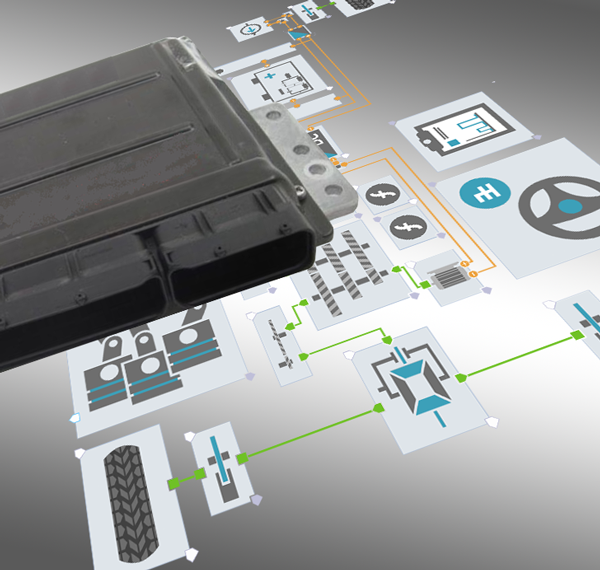The Importance of System Simulation for HEV Development

Hybrid Electric Vehicles (HEVs) combine the best of two worlds: a long range possible through an internal combustion engine, and lower consumption and emissions through electrification.
However, stringent legislative emissions requirements and the extra number of model variants increase complexity and put huge additional pressure on vehicle development. Hybrid vehicle systems consist of a large variety of components, each of them potentially influencing the performance of another. As system complexity grows, design optimization for single components like electric motors or inverters is not enough and enhancing the integration of individual components into the overall system becomes increasingly important.
With the global hybridization trend, the demand for innovative methods capable of meeting these challenges increases at a rapid pace. AVL offers simulation solutions that efficiently support the development of battery electric and hybrid electric vehicle powertrains – from system concept via component analysis to integration. This facilitates important concept and design decisions at a very early stage of development and proves their validity. However, before vehicle development work even begins, it is important to start with an in-depth understanding of the specific needs of the target customer group.
“We decide on the whole concept at the beginning,” said Oliver Knaus, team leader for solution management at AVL. “Who is the customer? What do they expect from their vehicle? What should the architecture look like, and how should the performance attributes be distributed?”
With the help of virtual prototypes, the overall vehicle powertrain can be optimized very early in the development process, long before physical prototypes become available. Virtual benchmarking enables the requirement-oriented specification of the component characteristics up front, meaning that the entire architecture and its sub-system attributes can be specified at the beginning of the development process. Rough specifications are initially given, which are then refined until the whole powertrain has been optimized on the computer.

“This is why we are so committed to making processes and workflows as seamless and intuitive as possible. Development costs are dramatically reduced with this ‘right-first-time’ approach. In addition, with the help of virtual benchmarking, our customers can compare their product against the competing market, long before the physical hardware exists,” said Knaus. Seamless processes rely on the management and exchange of data between all the relevant departments, at both system and component levels.
Another very important aspect in HEV powertrain development is the availability of optimized hybrid controllers. This requires a smart definition of the control strategy and an optimized set of control parameters. This can be achieved by multi-domain system simulation of the entire vehicle under realistic driving conditions in combination with Design of Experience (DoE) to ensure robust controller functions over a wide spectrum of vehicle operations.
In an upcoming webinar, AVL’s experts Christoph Triebl and Alessandro Colla will show how the energy balance of a hybrid vehicle can be optimized using innovative system simulation. Demonstrated use cases will include, setting up a control strategy and handling several design variants of controller parameters and functionalities.
However, stringent legislative emissions requirements and the extra number of model variants increase complexity and put huge additional pressure on vehicle development. Hybrid vehicle systems consist of a large variety of components, each of them potentially influencing the performance of another. As system complexity grows, design optimization for single components like electric motors or inverters is not enough and enhancing the integration of individual components into the overall system becomes increasingly important.
With the global hybridization trend, the demand for innovative methods capable of meeting these challenges increases at a rapid pace. AVL offers simulation solutions that efficiently support the development of battery electric and hybrid electric vehicle powertrains – from system concept via component analysis to integration. This facilitates important concept and design decisions at a very early stage of development and proves their validity. However, before vehicle development work even begins, it is important to start with an in-depth understanding of the specific needs of the target customer group.
“We decide on the whole concept at the beginning,” said Oliver Knaus, team leader for solution management at AVL. “Who is the customer? What do they expect from their vehicle? What should the architecture look like, and how should the performance attributes be distributed?”
With the help of virtual prototypes, the overall vehicle powertrain can be optimized very early in the development process, long before physical prototypes become available. Virtual benchmarking enables the requirement-oriented specification of the component characteristics up front, meaning that the entire architecture and its sub-system attributes can be specified at the beginning of the development process. Rough specifications are initially given, which are then refined until the whole powertrain has been optimized on the computer.

Plant model used for calibrating control units
Without virtual integration and the frontloading of development tasks, any wrong decisions will send the whole process right back to the start. In an industry where time-to-market is crucial, a setback like that could cost the development process several months.“This is why we are so committed to making processes and workflows as seamless and intuitive as possible. Development costs are dramatically reduced with this ‘right-first-time’ approach. In addition, with the help of virtual benchmarking, our customers can compare their product against the competing market, long before the physical hardware exists,” said Knaus. Seamless processes rely on the management and exchange of data between all the relevant departments, at both system and component levels.
Another very important aspect in HEV powertrain development is the availability of optimized hybrid controllers. This requires a smart definition of the control strategy and an optimized set of control parameters. This can be achieved by multi-domain system simulation of the entire vehicle under realistic driving conditions in combination with Design of Experience (DoE) to ensure robust controller functions over a wide spectrum of vehicle operations.
In an upcoming webinar, AVL’s experts Christoph Triebl and Alessandro Colla will show how the energy balance of a hybrid vehicle can be optimized using innovative system simulation. Demonstrated use cases will include, setting up a control strategy and handling several design variants of controller parameters and functionalities.




